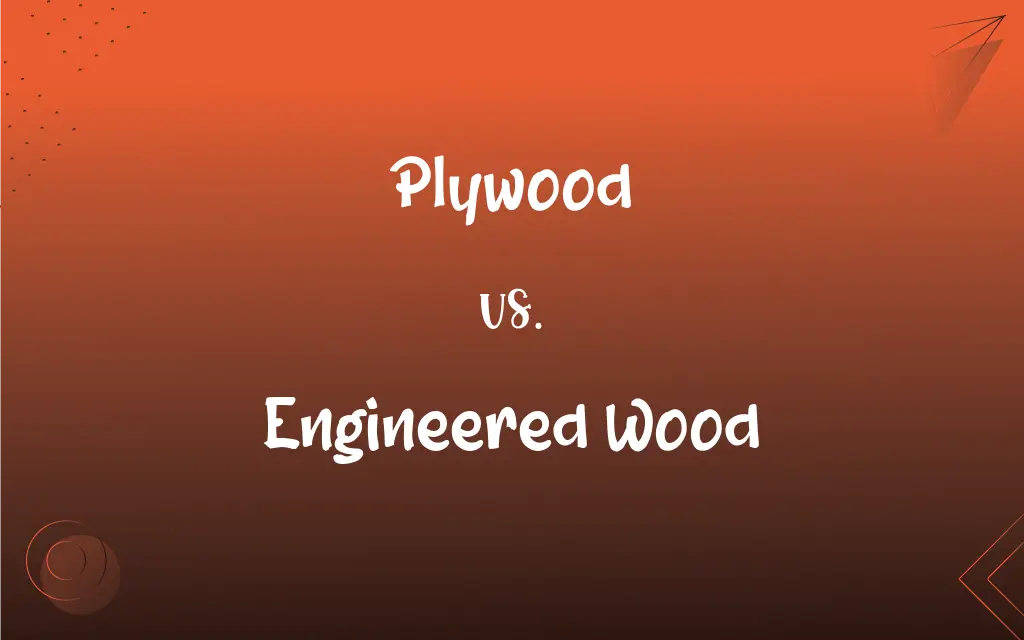Plywood vs. Engineered Wood: What's the Difference?
Edited by Aimie Carlson || By Janet White || Published on March 5, 2024
Plywood is a material made by gluing together several thin layers of wood veneer at alternating right angles for strength. Engineered Wood is wood products manufactured by binding or fixing strands, particles, fibers, or veneers with adhesives.

Key Differences
Plywood is constructed by gluing together multiple layers of wood veneer, with each layer’s grain oriented perpendicularly to adjacent layers, enhancing strength and reducing expansion. Engineered wood encompasses a broader range of products, including plywood, but also particleboard, MDF, and laminated veneer lumber, each made by combining wood materials and adhesives in various ways.
The strength of plywood comes from its cross-grained structure, which distributes load and resists warping. Engineered wood products like particleboard and MDF, however, are made from wood particles or fibers, offering different strengths and weaknesses, such as better uniformity but less strength compared to plywood.
Plywood is versatile, used in everything from furniture to construction, offering a balance of strength and weight. Engineered wood products vary widely; for example, MDF is great for detailed work due to its smoothness, while laminated veneer lumber is used for structural applications requiring high strength.
Environmental impact varies; plywood production can preserve more of the tree’s wood, reducing waste. Engineered wood products like particleboard efficiently use wood waste, but their manufacturing process can involve more adhesives, sometimes with formaldehyde and other chemicals.
Plywood can be used in moisture-prone areas if made with waterproof glue. Some engineered wood products are designed for moisture resistance, but others like MDF can swell and deteriorate with water exposure.
ADVERTISEMENT
Comparison Chart
Composition
Layers of wood veneer glued at right angles
Various, including particles, fibers, or veneers
Strength Characteristics
High strength, resists warping
Varies; some types less strong but more uniform
Typical Uses
Furniture, construction, flooring
Diverse, from furniture to structural components
Environmental Considerations
Often less waste, but depends on adhesive used
Efficiently uses wood waste; may use more adhesives
Moisture Resistance
Waterproof types available
Varies; some highly resistant, others not
ADVERTISEMENT
Plywood and Engineered Wood Definitions
Plywood
Suitable for a wide range of applications, from furniture to construction.
Plywood is popular in both cabinet making and general construction.
Engineered Wood
Includes a variety of products like MDF, particleboard, and laminated lumber.
Our kitchen cabinets are made from MDF, a type of engineered wood.
Plywood
Can be made water-resistant for outdoor use.
For the outdoor deck, we used water-resistant plywood.
Engineered Wood
Often made using recycled wood materials.
Engineered wood is environmentally friendly due to its use of recycled wood fibers.
Plywood
A strong, versatile wood material made from glued layers of veneer.
We used plywood for the subflooring due to its durability.
Engineered Wood
Used for diverse purposes depending on the specific type.
Engineered wood beams provide strong structural support.
Plywood
Offers good strength-to-weight ratio.
Plywood is chosen for its balance of lightness and strength.
Engineered Wood
Manufactured wood product combining wood with adhesives.
We selected engineered wood flooring for its uniform appearance.
Plywood
Composed of thin wood layers with alternating grain directions.
The alternating grains in plywood give it excellent strength.
Engineered Wood
Varies in moisture resistance depending on the type.
We avoided using certain types of engineered wood in damp areas.
Plywood
A structural material made of layers of wood glued together, usually with the grains of adjoining layers at right angles to each other.
Plywood
(uncountable) Construction material supplied in sheets, and made of three or more layers of wood veneer glued together, laid up with alternating layers having their grain perpendicular to each other.
After the hurricane there was a severe regional shortage of plywood, especially exterior plywood.
Plywood
(countable) A specific grade or type of this construction material.
We stock exterior plywoods, interior plywoods, and furniture plywoods.
Plywood
(transitive) To fit or block up with plywood.
Plywood
A laminate made of thin layers of wood
FAQs
Is plywood strong?
Yes, its cross-grained structure makes it strong.
What are common types of engineered wood?
Particleboard, MDF, and laminated veneer lumber.
What is plywood made from?
Thin layers of wood veneer glued together.
Can engineered wood be used for flooring?
Yes, certain types are suitable for flooring.
Is plywood suitable for outdoor use?
Waterproof types of plywood are suitable for outdoors.
Does engineered wood look like real wood?
Some types, like veneer lumber, closely resemble real wood.
Is engineered wood environmentally friendly?
Often, as it can utilize recycled wood and wood waste.
Can plywood be recycled?
Yes, but it depends on the type of glue used.
Are there health concerns with engineered wood?
Some types may contain formaldehyde or other chemicals.
How is plywood typically finished?
It can be painted, stained, or varnished.
Can plywood be used for furniture?
Yes, it's commonly used in furniture making.
How is engineered wood made?
By binding wood particles, fibers, or veneers with adhesives.
Does plywood resist warping?
Its layered structure helps resist warping.
What is a common use of plywood in construction?
Plywood is often used for roofing and subflooring.
Does engineered wood swell or deteriorate with moisture?
Some types, like MDF, can swell with moisture.
Is plywood resistant to termites?
Not inherently, but treated types can be.
Can engineered wood be used structurally?
Yes, products like laminated veneer lumber are used structurally.
Is MDF stronger than plywood?
Generally, plywood is stronger than MDF.
About Author
Written by
Janet WhiteJanet White has been an esteemed writer and blogger for Difference Wiki. Holding a Master's degree in Science and Medical Journalism from the prestigious Boston University, she has consistently demonstrated her expertise and passion for her field. When she's not immersed in her work, Janet relishes her time exercising, delving into a good book, and cherishing moments with friends and family.
Edited by
Aimie CarlsonAimie Carlson, holding a master's degree in English literature, is a fervent English language enthusiast. She lends her writing talents to Difference Wiki, a prominent website that specializes in comparisons, offering readers insightful analyses that both captivate and inform.







































































